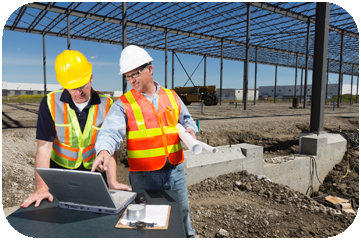How Consulting Engineers Enhance Geotechnical Engineering Projects: Insights Into Their Expertise, Techniques, and Collaborative Approaches
Consulting designers are crucial in boosting geotechnical design projects, applying their specialized expertise to navigate the complexities of subsurface problems. Their collaborative techniques foster communication amongst diverse task stakeholders, eventually forming the project's trajectory.
Role of Consulting Engineers
The expertise of seeking advice from designers in geotechnical engineering is essential to the successful implementation of building projects. These specialists play an essential role in assessing dirt and rock buildings, which are crucial aspects affecting style and building decisions. By conducting extensive site investigations, seeking advice from designers accumulate vital data that informs the design process, making certain jobs are improved secure and suitable ground.
Consulting engineers additionally provide important understandings right into risk monitoring (geotechnical geologist). They recognize possible geotechnical hazards, such as landslides, dirt liquefaction, and settlement concerns, making it possible for stakeholders to apply efficient mitigation strategies. Their competence aids in enhancing structure styles, which can result in substantial price financial savings and enhanced safety
Moreover, consulting engineers offer as an important link between task proprietors, designers, and contractors. Their capacity to convert complicated geotechnical data into workable recommendations cultivates partnership and facilitates notified decision-making throughout the project lifecycle. This multidisciplinary approach not only boosts project effectiveness yet likewise makes certain compliance with regulatory standards and finest practices.
Key Techniques in Geotechnical Engineering

One main method is site examination, which involves conducting area tests and laboratory evaluations to gather information on subsurface problems. Methods such as Criterion Infiltration Screening (SPT) and Cone Infiltration Screening (CPT) are widely utilized to review dirt stratigraphy and toughness. Additionally, geophysical approaches, including seismic and electrical resistivity studies, give non-invasive methods to examine subsurface attributes.
An additional vital approach is mathematical modeling, which allows engineers to simulate different scenarios and forecast exactly how soil-structure interactions will act under different loading conditions. Limited Component Analysis (FEA) is a typical strategy used in this context.
Moreover, the layout of foundations, keeping frameworks, and earthworks relies heavily on these techniques - geotechnical geologist. By incorporating advanced logical tools with area data, getting in touch with designers can develop tailored options that attend to specific project difficulties, eventually adding to the stability and security of building and construction projects
Relevance of Dirt Evaluation
Dirt evaluation serves as a foundational element in geotechnical design, offering necessary insights into the physical and chemical residential properties of dirt required for efficient building planning. Recognizing dirt features is essential for establishing its load-bearing capacity, drain habits, and possibility for negotiation or instability. In-depth soil investigations, including sampling and laboratory testing, assistance determine parameters such as dirt type, moisture material, thickness, and shear toughness.
These analyses notify the selection of appropriate building techniques and materials, ultimately affecting task safety and long life. Cohesive soils may require different foundation styles compared to granular soils, demanding tailored design remedies. In addition, dirt evaluation aids in identifying impurities that could posture risks to human health or the setting, permitting the development of reduction approaches.
Including dirt evaluation right into the onset of task advancement assists to lessen unpredicted obstacles, making sure that engineers can anticipate and resolve potential concerns before they intensify. By developing a thorough understanding of the website problems, consulting engineers can maximize design effectiveness and minimize expenses, consequently improving the total success of geotechnical engineering tasks.
Joint Techniques in Projects
Successful geotechnical jobs commonly depend upon collective strategies that combine diverse proficiency from different techniques. Effective collaboration among consulting engineers, rock hounds, ecological scientists, and building and construction specialists is important for resolving complicated obstacles and enhancing project outcomes. By leveraging the special abilities and expertise of each staff member, jobs can benefit from an all natural understanding of the site problems, regulative demands, and design restrictions.
Regular communication and interdisciplinary meetings promote the sharing of understandings and foster a society of synergy. These joint efforts enable the identification of possible dangers early in the job lifecycle, permitting prompt reduction approaches. In addition, including comments from stakeholders, including local communities and regulatory firms, makes sure that straight from the source all viewpoints are taken into consideration, boosting job acceptance and conformity.
In addition, the assimilation of innovative technologies, such as Geographic Info Equipment (GIS) and Structure Information Modeling (BIM), additional improves partnership. These tools enable the real-time sharing of information and visualization of geotechnical problems, advertising educated decision-making. Ultimately, a joint approach not just improves project implementation but also lays the structure for ingenious remedies to complicated geotechnical engineering obstacles.
Impact on Project Results

Consulting designers use advanced methodologies such as danger assessment and predictive modeling, which improve the precision of job forecasts. Their ability to integrate cutting-edge technologies, like geotechnical instrumentation and information analytics, additionally improves the design and building and construction processes. As a result, tasks experience improved efficiency, lowered costs, and decreased hold-ups.
In addition, cultivating reliable communication and cooperation among employee enhances problem-solving abilities. When difficulties develop, an unified front enables swift recognition of options, protecting against prospective troubles. Eventually, the collective initiatives of speaking with designers add to better end results, making certain that tasks satisfy both regulative requirements and client expectations.
Final Thought
